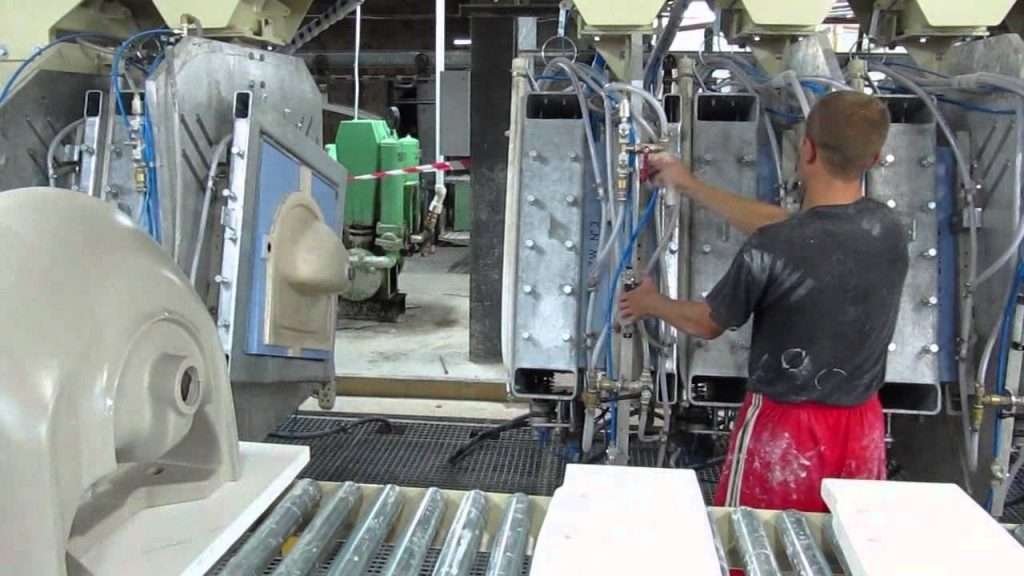In this article we are going to Look about High Pressure Casting Machine used in Sanitaryware Factories, Process Steps involved, Parameters, Technologies, Advantages & limitation.
[toc]
Overview:
High-pressure casting machines, also known as HPCM, represent advanced technology in the sanitary ware manufacturing industry. Reputed companies produce these machines, emphasizing the need for reliable manufacturers to minimize maintenance costs. Maintaining a high-pressure casting machine poses unique challenges due to its operation under extremely high pressure and speed. The technology employed allows for cycle completion in as little as 20 minutes, a significant improvement over traditional bench casting that can take up to 8 hours per cycle. This represents a remarkable 1920% increase in production speed, showcasing the substantial technological advancement.

A single cycle of high-pressure casting can yield 4 to 6 water closets, 36 pedestals, 24 to 30 combinations of washbasins and pedestals, or approximately 44 pieces of Orissa Pan. The cycle time varies between 20 to 45 minutes, depending on the specific sanitary ware model produced by the machine.
Process involved in high pressure casting machine
The high-pressure casting process follows similar steps to other casting methods in sanitary ware production, with the key distinction being the automation of many processes. The machine’s PLC program automates tasks such as mold clamping, pipe and mold cleaning, slip filling, unloading, and demolding. Unlike traditional methods, high-pressure casting uses resin molds instead of ordinary plaster molds. The slip is heated to 45 degrees Celsius to achieve a high casting rate during layer formation. The entire casting process is controlled by a programmed sequence of technologies, each executed manually as per requirements.
Main stages of Technologies
- Moulds Closure: Used to clamp the molds.
- Filling: Slip filling into the molds from the slip tank.
- Layer Formation (10 to 13 bars HP): Rapid thickness formation under high pressure.
- Decompression: Reducing pressure inside the mold.
- Drainage: Unloading excess slip using air.
- Hardening: Drying the ware for handling strength, performed using air.
- Decompression: Returning the mold to atmospheric air by venting.
- Moulds Opening: Releasing the clamp and opening the mold.
- Demoulding: Applying water to demold the green wares.
- Air to Moulds: Removing excess water or for cleaning purposes.
- Water to Moulds: Maintaining moisture content during demolding.
- Vacuum to Moulds: Providing vacuum during excess water or cleaning.
- Flushing & Cleaning of Pipes and Moulds: Post-conditioning and pre-conditioning.
Parameters
Critical parameters to maintain in a high-pressure casting machine include:
- Pressure: 10 to 13 bar
- Slip temperature: 45ºC to 47ºC
- Litter weight: 1900 to 1920
- Fluidity: 320 ± 5
- One-minute Thixotropic: 40 ± 5
Advantages of high-pressure casting machine
- Continuous production without stopping for mold changes.
- Low manpower requirement in comparison to the quantity produced.
- Compact space requirements compared to bench casting & battery casting machines.
- Minimal skill required for operators, ensuring excellent product finishing.
limitations
- High initial setup cost.
- Elevated maintenance expenses compared to other casting techniques.
- Limited capability to produce complex products like one-piece toilets.
Conclusion
The high-pressure casting machine offers a rapid and efficient production process akin to a flight but comes with a price tag. It is particularly suitable for industries with high manpower costs, while its viability diminishes in regions where labor costs are lower.
For further inquiries or if you are a supplier of high-pressure casting machines, feel free to leave a comment below with your details.
See also sanitaryware Glazed by dipping method.


7 Comments
we wanna set up factory and want to know which way is the best
sr.i am working in a sanitary factory in iran. i want to know about responsibilty of silica size in dunting during firing.
Thanks for the insight. Our company is interested in acquiring such a machine with other necessary components. What will be the estimated cost of such machine and if there is a catalog, that would be helpful.
HI,
Thanks for your comment. you can contact SACMI or PCL ceramics for quote..
Thanks
Venkat
Sir we r sanitary ware machinery manufacturer like battery casting,grinding machine…etc in Gujarat (mehsana),name-better engineers.
Nice article.. This site is a good intiative.. Please Write a article about sanitaryware robot spraying..
If we have required this high pressure casting than where should we contact ? and what will be cost of this machine ?